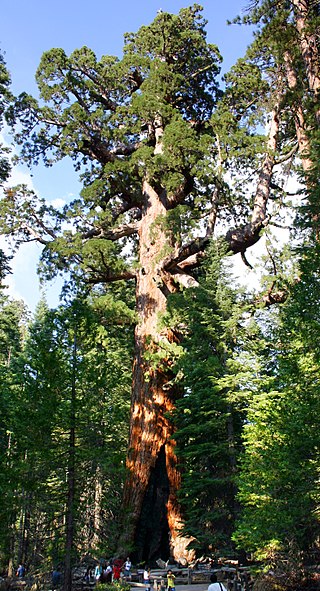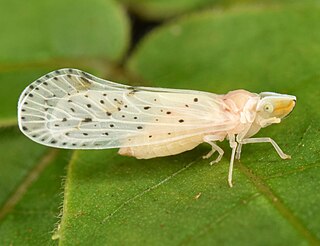
Quail is a collective name for several genera of mid-sized birds generally placed in the order Galliformes. The collective noun for a group of quail is a flock, covey, or bevy.

A pine is any conifer tree or shrub in the genus Pinus of the family Pinaceae. Pinus is the sole genus in the subfamily Pinoideae.

Sequoiadendron giganteum, also known as the giant sequoia, giant redwood or Sierra redwood is a coniferous tree, classified in the family Cupressaceae in the subfamily Sequoioideae. Giant sequoia specimens are the most massive trees on Earth. They are native to the groves on the western slopes of the Sierra Nevada mountain range of California but have been introduced, planted, and grown around the world.

John Muir, also known as "John of the Mountains" and "Father of the National Parks", was a Scottish-born American naturalist, author, environmental philosopher, botanist, zoologist, glaciologist, and early advocate for the preservation of wilderness in the United States.

Muir Woods National Monument is a United States National Monument managed by the National Park Service and named after naturalist John Muir. It is located on Mount Tamalpais near the Pacific coast in southwestern Marin County, California. The Monument is part of the Golden Gate National Recreation Area, and is 12 miles (19 km) north of San Francisco. It protects 554 acres (224 ha), of which 240 acres (97 ha) are old growth coast redwood forests, one of a few such stands remaining in the San Francisco Bay Area.
Hobart Muir Smith, born Frederick William Stouffer, was an American herpetologist. He is credited with describing more than 100 new species of American reptiles and amphibians. In addition, he has been honored by having at least six species named after him, including the southwestern blackhead snake, Smith's earth snake, Smith's arboreal alligator lizard, Hobart's anadia, Hobart Smith's anole, and Smith's rose-bellied lizard. At 100 years of age, Smith continued to be an active and productive herpetologist. Although he published on a wide range of herpetological subjects, his main focus throughout his career was on the amphibians and reptiles of Mexico, including taxonomy, bibliographies, and history. Having published more than 1,600 manuscripts, he surpassed all contemporaries and remains the most published herpetologist of all time.

Delphacidae is a family of planthoppers containing about 2000 species, distributed worldwide. Delphacids are separated from other "hoppers" by the prominent spur on the tibia of the hindleg.

The family Derbidae is a large and diverse group of planthoppers, widely distributed in the tropics and also found in subtropical and temperate regions. It includes more than 150 genera and more than 1500 species. The adults suck the sap of plants while the nymphs live mainly in decaying organic matter, for example under the bark of dead tree trunks, feeding on fungi. In some groups of species the general structure of the insects is largely uniform, whereas in others like in the subfamily Otiocerinae various forms can be found. For example, the shape of the head, the antennae or the wings can differ considerably among genera and species.
The University of Wisconsin–Madison Lakeshore Nature Preserve is a 300-acre (1.2 km2) nature reserve along 4 miles (6.4 km) of the southern shore of Lake Mendota. The preserve's primary goals are to protect native plant and animal communities, as well as to uphold the campus's signature natural landscapes, all while providing an educational facility for the university.

Sequoia is a genus of redwood coniferous trees in the subfamily Sequoioideae of the family Cupressaceae. The only extant species of the genus is Sequoia sempervirens in the Northern California coastal forests ecoregion of Northern California and Southwestern Oregon in the United States. The two other genera in the subfamily Sequoioideae, Sequoiadendron and Metasequoia, are closely related to Sequoia. It includes the tallest trees, as well as the heaviest, in the world.

Sherwin John Carlquist FMLS was an American botanist and photographer.
Helen Marguerite Muir-Wood was a British paleontologist and historian of paleontology who spent her career at London's Natural History Museum. She is a recipient of the prestigious Lyell Medal for her contributions to the field.
Perkinsiella is a genus of delphacid planthoppers in the family Delphacidae. There are more than 30 described species in Perkinsiella.
The Gengidae are a family of Fulgoromorpha (planthoppers), with species found in South Africa.

The Achilixiidae are a family of Fulgoromorpha (planthoppers); species may be found in the neotropical and Asian regions. They are closely related to Achilidae and are sometimes included under Achilidae as a subfamily. Like Achilidae, species generally feed on several species of plant though the nymph stage has been found to feed on fungus. Like other planthoppers, the immature stage is covered in a wax which may help protect it from predators. Achilixiidae are small or medium sized for planthoppers and are greatly compressed, not depressed like the Achilidae.
Platidiidae is a family of brachiopods belonging to the order Terebratulida.
Phaneropora is a genus of brachiopods belonging to the family Platidiidae.
Cryptopora is a genus of brachiopods belonging to the family Cryptoporidae.
Dallithyris is a genus of brachiopods belonging to the family Terebratulidae.









